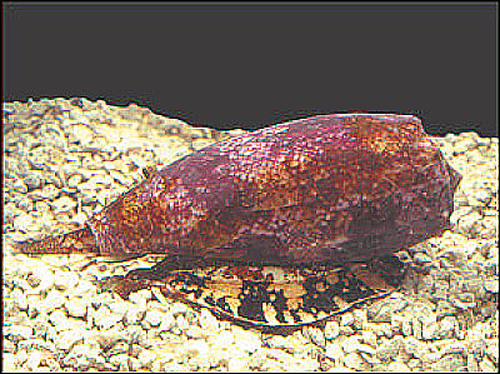Geographic Cone Snail
Conus geographus
The geographic cone is also known by the name Anbonia, a name derived from its discovery in the Gulf of Anbonia in Indonesia. This fairly large cone is the most dangerous of the cone shell species.

Credit: Courtesy NIGMS
SPECIES IN DETAIL
Geographic Cone Snail
Conus geographus
CONSERVATION STATUS: Safe for Now
CLIMATE CHANGE: Not Applicable
At the Aquarium
This species is not currently on exhibit at the Aquarium.
Geographic Distribution
Tropical Indo-Pacific region, Australia.
Habitat
Geographic cones live in sand pockets near reef edges, under dead coral rubble or among coral reefs.
Physical Characteristics
This beautiful cone has a lightweight and thin but not fragile shell. Slightly glossy, the shell is oval and cylindrical with parallel sides that constrict to a narrower base. The body of the shell has slightly angled depressions that resemble wrinkles. The aperture is wide at the bottom. The shoulder of the shell is wide and angled, with a low spire and rounded coronations.
The background color is some variation of white, cream, pink or blue, heavily covered with fine brownish lines and irregular brownish blotches.
Size
The geographic cone snail is 7-15 cm (2.8-6 in) in length.
Diet
They are nocturnal piscivores. They feed at night by stunning and capturing several small fish that they store internally. After gathering enough for a meal, they eat them individually.
Reproduction
Follow this link for additional information on cone snails.
Special Notes
Geographic cone snails are known to have caused a number of human deaths. Their long and highly expendable proboscis is capable of reaching any part of its shell, which means it cannot be safely picked up by hand.
SPECIES IN DETAIL | Print full entry
Geographic Cone Snail
Conus geographus
CONSERVATION STATUS: Safe for Now
CLIMATE CHANGE: Not Applicable
This species is not currently on exhibit at the Aquarium.
Tropical Indo-Pacific region, Australia.
Geographic cones live in sand pockets near reef edges, under dead coral rubble or among coral reefs.
This beautiful cone has a lightweight and thin but not fragile shell. Slightly glossy, the shell is oval and cylindrical with parallel sides that constrict to a narrower base. The body of the shell has slightly angled depressions that resemble wrinkles. The aperture is wide at the bottom. The shoulder of the shell is wide and angled, with a low spire and rounded coronations.
The background color is some variation of white, cream, pink or blue, heavily covered with fine brownish lines and irregular brownish blotches.
The geographic cone snail is 7-15 cm (2.8-6 in) in length.
They are nocturnal piscivores. They feed at night by stunning and capturing several small fish that they store internally. After gathering enough for a meal, they eat them individually.
Follow this link for additional information on cone snails.
Geographic cone snails are known to have caused a number of human deaths. Their long and highly expendable proboscis is capable of reaching any part of its shell, which means it cannot be safely picked up by hand.

